|
The Clyde has the honourable distinction of being the
first European river on which the steamboat was used commercially.
Various attempts had been made from time to time by many ingenious
inventors to apply the steam-engine to propel vessels. Amongst the
earliest of these is the patent of Jonathan Hulls, in 1736, for a
tow-boat, having a rotatory paddle at the stern, driven by a steam
apparatus placed in the boat. It is said, however, that Denis Papin,
in 1707, invented a steamboat in which he ascended the river Weser.
The inhabitants on the banks, resenting this innovation on their
boating privileges, are said to have destroyed his vessel. Curiously
enough, since history is said to repeat itself, the same sudden
termination to another and like effort of applied science seems to
have taken place nearer home, as tradition says that the boatmen of
Loch Katrine were so indignant at the appearance of the first
steamer which was placed on this beautiful sheet of water that they
managed to sink her. These stories seem probable enough when we find
that the feeling at coast places was so strong against the
steamboats that they were not allowed to approach the quay, and it
is said that a steamer lying off one of the coast towns had her
cables cut, some of the old boatmen being of the belief that she was
aided by the powers of evil.
Papin, who appears to have been a very able man,
turned his attention, so far back as the year 1690, to improvements
in the cylinders of the rude steam appliances of his day, and it is
said that he conceived the idea of moving a piston in a cylinder by
the alternate action of the pressure and condensation of steam
effected in the cylinder,—the great improvement of Watt, in 1761,
was the condensation of the steam in a separate vessel called the
condenser, whereby the loss of power due to the alternate heating
and cooling of the cylinder, as in Newcomen’s engine, was overcome.
An important attempt to utilize steam to propel
vessels was made by Patrick Miller of Dalswinton, on Dalswinton
Loch, Dumfriesshire, in the year 1788. The boat used in the
experiments had a double hull, thus anticipating the twin boats
afterwards tried from time to time, one now working successfully, on
the English Channel. It measured 25 feet in length by 7 feet in
breadth, and was fitted with two paddle-wheels, one before and the
other behind the engine. It appears that Mr. Miller was endeavouring
to find some means of turning paddles fitted into small boats with
which he was experimenting, and a Mr. Jas. Taylor suggested the
steam-engine as a propelling power. This suggestion was, however,
met by the following reply from Mr. Miller: “That is a powerful
agent, I allow, but will not answer my purpose, for when I wish
chiefly to give aid it cannot be used. In such cases as the
disastrous event which happened lately, of the wreck of a whole
fleet upon a lee-shore, off the coast of Spain, every fire on board
must be extinguished, and, of course, such an engine could be of no
use.” Later on it was determined to try the steam-engine, and a
young mechanic,
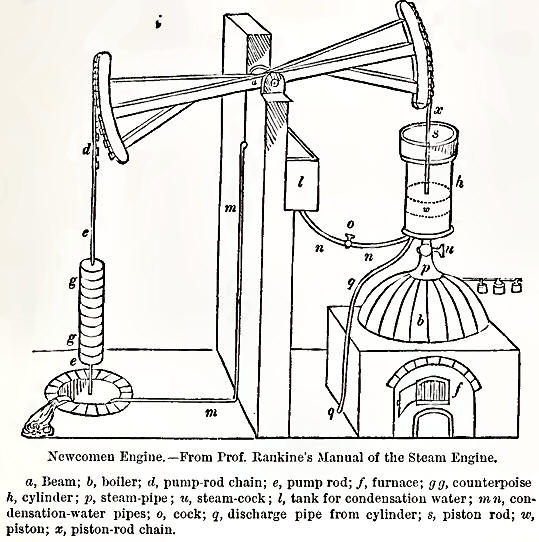
Wm. Symington, was employed to superintend its
construction at Edinburgh. The result was very satisfactory, as the
vessel moved at the rate of 5 miles an hour. The boat was afterwards
laid up, and in 1789 Mr. Miller, with Taylor and Symington as
assistants, made another experiment, this time on the Forth and
Clyde Canal near Carron, at which works the engine was made. The
first trial was unsuccessful, as the paddle-wheels gave way when
full power was put on. This defect was soon remedied and a
successful trial made, the speed being nearly 7 miles an hour. The
expense and trouble in connection with this experiment caused Mr.
Miller to have the boat dismantled, although he still intended to
work out his ideas on steam propulsion.
In 1801 Lord Dundas employed Symington to fit up a
steamboat for trial on the canal, and in 1802 the vessel named Charlotte
Dundas was
tried on the Forth and Clyde Canal. In this vessel Symington
introduced the important addition of a crank connection with the
paddle-wheel, whereby a direct rotatory action was kept up. The
engine was, in this way, much in advance of those previously tried,
and curiously enough remained in advance of many of the after-made
machinery for propelling the Clyde steamers, where, instead of the
action being directly applied, as in this case, the motion of the
wheels was obtained through intermediate levers and spur-wheel
gearing. In reference to this, Professor Rankine, in his Manual
of the Steam Engine,
says: “The Charlotte
Dundashad
one paddle-wheel near the stern, driven by a direct-acting
horizontal engine, with a connecting-rod and crank. The arrangement
of her mechanism was such as would be considered creditable at the
present day; and she has been justly styled by Mr. Woodcroft ‘ the
first practical steamboat.’ ”
It may be mentioned that one of the first iron
vessels was built at Faskine, on the Monkland Canal, a few miles
east of Glasgow. She was named the Vulcan, and
started with passengers from Port-Dundas to Lock 16 on the loth
September, 1819. Forty-five years afterwards she was still in good
condition, but doing service as a cargo boat.
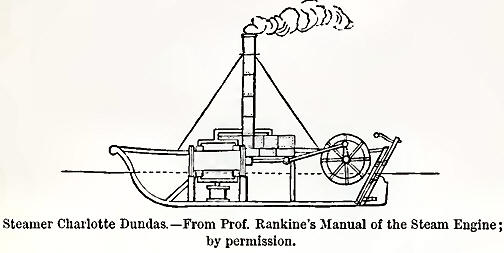
The following verses, written by William Muir, Bird-ston,
near Kirkintilloch, in March, 1803, on seeing the Charlotte
Dunclas pass
on the canal, are interesting, as giving us a humorous glimpse into
the past, enabling those of the present day who are familiar with
such splendid achievements in marine architecture as are seen on our
ocean highways, to appreciate to some extent the difficulties which
at that time had to be overcome, and the wonder and amazement of the
beholders of the early attempts at steam propulsion:—
“When first, by labour, Forth an’ Clyde
Were taught o’er Scotia’s hills to ride,
In a canal, deep, lang, an’ wide,
Naebody thocht
That winders, without win’ or tide,
Would e’er be wrocht.
“To
gar them trow that boats would sail
Thro’ fields o’ corn or beds o’ kail,
An’ turn o’er glens their rudder’s tail,
Like weathercocks,
Was doctrine that wad needed bail
Wi’ common folks.
“They ca’d it nonsense, till at last
They saw boats travel east and wast,
Wi’ sails an’ streamers at their mast,—
Syne, without jeering,
They were convinced the blustering blast
Was worth the hearing.
“For mony a year, wi’ little clatter,
An’ naething said about the matter,
The horses haul’d them through the water,
Frae Forth tae Clyde;
Or the reverse, wi’ weary splatter,
An’ sweaty side.
“But little think we what’s in noddles,
Whar
Science sits an’ grapes and guddlcs,
Syne darklins forth frae drumly puddles,
Brings forth to view
That the weak penetration fuddles O’ me an’ you.”
The author then refers to the new lighter as being
driven
“Wi’
something that the learned ca’ steam;”
and adds:—
“By
it she through the water plashes,
An’ out the stream behiut her dashes
At sic a rate, baith frogs and fishes
Are forced to scud,
Like ducks and drakes amang the rashes,
To shun the mud.”
And after this vivid description of the rapid
movement of the novelty, he proceeds to speculate on what he has
seen:—
“Can
e’er, thought I, a flame o’ reek,
Or boiling water’s cauldron smeek,
Tho’ it war keepit for a week,
Perform sic wonders,
As quite surprises maist the folks
O’ gazin’ hunders?”
And finally finishes in a philosophic and prophetic
vein:—
“But facts, we canna well dispute them,
Altho’ we little ken about them;
When prejudice inclines to doubt them
Wi’ a’ her might
Plain demonstration deep can root them,
An’ set us right.
“Or lang gae now, wi’ whirligigs
An’ steam engines we’ll plough our rigs,
An’ gang about on easy legs
Wi’ nought to pain us,
But flit in tethers needless nags
That used to hain us.”
Returning, however, to the Clyde, we come upon a
notable period in our history, as in the year 1811 Henry Bell
arranged with John Wood, of Port-Glasgow, to build a vessel for him,
to be fitted with an engine by John Robertson of Glasgow. This
vessel was launched in June, 1812, with steam up, and made her first
trip to Helensburgh. She was named the Comet,
after a famous meteor which had shone across the heavens for some
time previous. This
vessel, the precursor of the long
line which followed, year by year, in growing numbers, was fitly
named. She was to many as much an apparition as the strange and
uncanny visitor of the skies, and, as with it, her train of
successors has spread, like a tail, far out in ever-widening sweep.
The Comet was
a wooden boat, 42 feet long, 11 feet broad, and 5 feet 6 inches
deep. She had the usual long funnel of the early steamers, and it
occasionally did duty as a mast, a large square sail being hoisted
on it when the wind was favourable. The engine was made by John
Robertson, and was a condensing one of 3 horse-power, the diameter
of the cylinder being 11 inches and the stroke 16 inches. The crank
worked below the cylinder; and the engine shaft was of cast-iron,
square in section, and measured 3J inches on the side. A fly-wheel
was added to equalize the motion. The vessel was originally fitted
with two pair of paddle-wheels, 7 feet in diameter, having
spur-wheels of 31 feet diameter attached, so that, by means of
another spur-wheel of the same diameter, placed between these, and
gearing into them, each pair of paddles was rotated at the same
speed. This arrangement was obviously very inefficient, as the one
pair of paddle-wheels worked in the wash of the other pair, besides
the loss of power due to working through the toothed wheels. It is
said that Robertson, the engineer, tried to dissuade Bell from
arranging his wheels in this manner, but the latter stuck firm to
his idea, and the boat was tried with them, but proved a failure.
The double wheels were then removed, and Robertson made another
engine of about 4-horse power,having a cylinder of 121 inches
diameter. The workshop where the engine of this famous steamer was
made was situated in Dempster Street, a small street off North
Frederick Street, in the north part of Glasgow. The original model
of the Comet is
in the possession of Messrs. John Reid & Co., shipbuilders,
Port-Glasgow, and shows the double set of paddle-wheels as
originally proposed and tried. See plate, which is a facsimile from
a photograph of the original draft of this vessel, kindly supplied
by Henry M. Napier, Esq. The drawing shows the vessel in both plan
and section, with the first-tried arrangement of the double
paddle-wheel on each side, also the spur-wheel gearing connecting
the engine with the paddles.
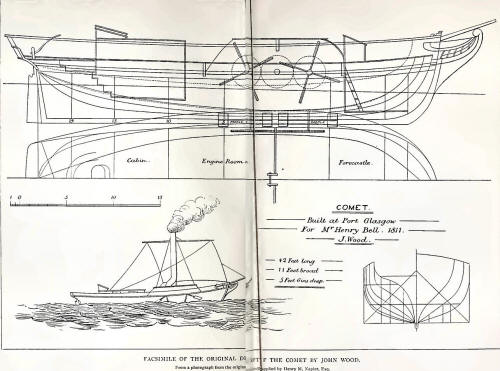
The navigation of the river had up till this time
been managed by boats, which, with the combined exertions of sail
and oars, made the passage up and down the river at more or less
regular intervals, as the time of the passage depended much upon
wind and tide. Thus Pennant, visiting the Clyde in 1772, tells us
that after passing Dumbarton, on his way to Greenock, they had “a
long contest with a violent adverse wind and very turbulent water.”
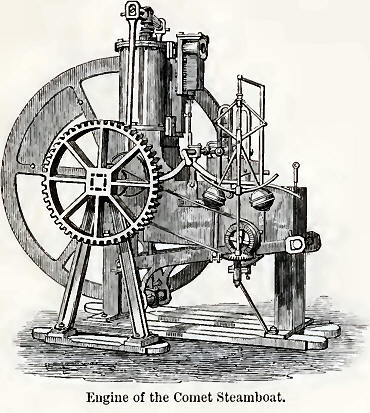
Bell appears early to have turned his attention to
the use of the paddle with hand power, some attempts having been
also made in this direction by a Mr. Bennie of Greenock. As in later
trials of this method of propulsion, the labour was found greater
than that required with the oar. It might, however, be supposed
that, by the use of ball-bearings, which have so much conduced to
the success of the modern velocipede, the resistance due to the
friction of the shaft of a paddle-wheel open pleasure-boat might be
greatly reduced. It is said that Brunei fitted a collar to the
rudder-post of the Great
Eastern, which,
resting on cannon balls, became really an early form of
ball-bearing.
The boiler of the Comet was
made by David Napier, a name to be afterwards widely associated with
the progress of steam shipping on the Clyde. The following is a copy
of Bell’s advertisement of his new boat: “The Steamboat Comet, between
Glasgow, Greenock, and Helensburgh, for passengers only.—The
Subscriber, having at much expense fitted up a handsome vessel to
ply upon the river Clyde from Glasgow, to sail by the power of air,
wind, and steam. He intends that the vessel shall leave the
Broomielaw on Tuesdays, Thursdays, and Saturdays, about mid-day, or
such an hour thereafter as may answer from the state of the tide;
and to leave Greenock on Mondays, Wednesdays, and Fridays, in the
morning, to suit the tide. The elegance, comfort, safety, and speed
of this vessel require only to be seen to meet the approbation of
the public; and the proprietor is determined to do everything in his
power to merit general support. The terms are for the present fixed
at 4s. for the best cabin and 3s. for the second, but beyond these
rates nothing is to be allowed to servants or any person employed
about the vessel.
“The subscriber continues his establishment at
Helensburgh Baths, the same as for years passed, and a vessel will
be in readiness to convey passengers by the Comet from
Greenock to Helensburgh.
“Helensburgh Baths, 5th August, 1812.”
This advertisement of Bell’s in which the power of
wind is referred to, brings up forcibly the condition of the early
navigation of the Clyde when the passenger communication with
Greenock and the other lower ports of the river was carried on by
means of what were termed Fly-Boats, which
made their passage to and fro by means of the power of wincl and
oars, occasionally, it is said, being helped by horse power. The
incidents in such journeys must have been frequently of a humorous
description, as the following graphic sketch which appeared some
years ago in the Glasgow
Herald will
show: “The passage to Greenock in favourable circumstances was
accomplished in about ten or twelve hours; as much depended on the
flow of the tidal wave, not unfrequently the passage was interrupted
for a night at Bowling. It was surmised that the flies were
intercepted there by a net or web in the shape of a tavern. The
passengers had frequently to remain in their ark, or get quarters in
the ‘public’ until the morning. A story was told and vouched that
when a ‘fly ’ had been thus arrested for the night, and the crew
were called in early and dusky morn to avail themselves of the
favourable tide, the two boatmen, who had been meantime indulging in
strong drink, set to work with their oars. With the dawn the
passengers had a dreamy notion that they were making little or no
progress as the outline of the castellated rock, still phantom-like,
appeared in the mist. Calling the attention of the rowers to their
apprehensions, the fact was painfully realized by the following
colloquy between the ancient mariners: ‘Tonalt, did you lift t’
anchor?’ and the discouraging reply,‘Na,Tougal, not me, but ’twas
your duty.’” From the Memorials
of James Watt we
learn that these Flyboats were built by W. Nicol, a Greenock
boatbuilder, and that they were a great improvement on the smaller
packet boats. They measured about 28 ft. in length by 8 ft. beam,
and were wherry-rigged. The passengers were protected from the
weather by a cover over the after part of the boat. A projecting
platform ran round the deck outside of this cabin for the crew to
pass and repass, and on fine weather by favour of the commanding
officer some of the passengers were allowed to sit upon the roof
with their feet on the passage way. The boats generally left
Greenock with the flood-tide, and if the wind was also favourable
Glasgow might be arrived at in from four to five hours. As late as
1820-1830 fly-boats without sails were used; these were simply large
stout open boats, which were rowed by four men. They plied to
Greenock from the foot of a long flight of stairs at the Broomielaw.
About that time the passage to Greenock by the steamers took
sometimes three hours, and the cost was 5s. in the cabin and 2s.
6c?. in the steerage. A wherry sailed from Greenock to Helensburgh
and the Gareloeh in opposition to
the steamers.
To facilitate this traffic there was a towing-path
down as far as Renfrew, and it is interesting to read in Cleland’s Annals
of Glasgow under
“Abstract of Regulations for Steam Boats and other Vessels.”—“That
none of the said Steamboats shall cross the tracking or towing lines
of the vessels plying on the river where there is room to pass on
the off side, under the penalty of £5 for
each offence.” And further “ That none of the said Steamboats shall
ply in the twilight or in the dark without having lights ahead
fitted up properly.” This regulation does not intimate the colour of
the lights, or if they were to be fitted to the paddle-boxes; and it
was no doubt at a later date that the well-known red and green
paddle-box lights were introduced, which, on first sight, frightened
some of the boatmen who happened to be out on the river during a
heavy spate, one of them declaring that an apothecaries’ shop had
been carried away and was drifting down on them.1
Even after the introduction of the steamboats the
shallow condition of the Clyde at low water, together with the
numerous sandbanks, made the navigation difficult and somewhat
uncertain, as the boats frequently got aground and had to lie till
the tide rose, the passengers sometimes assisting in getting a start
by running from side to side to loosen the keel out of the sand.
Besides the use of coloured lights for the more complete guidance of
vessels meeting or crossing each other’s path, the position and
method of fixing the lamps are now specified. Thus a steamship shall
carry on the front of the foremast at a height of not less than
twenty feet a bright white light, on the starboard side a green
light, and on the port side a red light. A sailing vessel shall
carry the red and green side-lights only. The rules for the
mariner’s guidance have been humorously put into rhyme by Thomas
Gray, C.B., secretary to the Board of Trade, thus:
TWO STEAMSHIPS MEETING.
“When all three lights I see ahead,
I port my helm and show my Hed.
TWO STEAMSHIPS PASSING.
Green to Green, or Tted to Ped—
Perfect safety—go ahead !
Very safe and good advice is given in the last
stanza:
“Both in safety and in doubt,
I always keep a good look-out;
In danger, with no room to turn,
I ease her! Stop her ! Go astern!”
The connection with places further down the river was
accomplished by the steamboats carrying the passengers to Greenock,
who then went by sailing packets to their destination. It is
recorded by a traveller in 1815 that he sailed in the Comet from
Glasgow for Greenock, leaving in the morning and arriving at
Greenock after a seven hours’ passage, three hours of which had,
however, been spent lying on a sand-bank at Erskine. At Greenock he
went on board the Rosa packet
and landed in Rothesay the same day, much to the surprise of the
residen-tcrs there, as the passage was an extraordinarily fast one.
The Comet was
followed by the Elizabeth, of
33 tons, built in 1812-13, by John Wood. She measured 58 ft. long
over all, 51 ft. keel, 12 ft. beam, and was 5 ft. deep. The engine
was made by James Cook of Trades-ton, Glasgow, and was of 10 h.p. The
following copy of an advertisement in reference to this steamer is
given in a work on Steam
and Steam Navigation, by
J. Scott Russell, and is interesting as giving us a good deal of
insight into the appearance and management of the early Clyde
steamers: “The Elizabeth was
started for passengers on the 9th of March, 1813, and has continued
to run from Glasgow to Greenock daily, leaving Glasgow in the
morning and returning the same evening. The passage, which is
twenty-seven miles, has been made, with a hundred passengers on
board, in something less than four hours, and in favourable
circumstances in two hours and three-quarters. The Elizabeth has
sailed eighty-one miles in one day, at an average of nine
miles an houv. The
Elizabeth measures
aloft tifty-eight feet; the best cabin is twenty-one feet long,
eleven feet three at mid-ships, and nine feet four inches aft,
seated all round, and covered with handsome carpeting; a sofa,
clothed with maronc, is placed at one end of the cabin, and gives
the whole a warm and cheerful appearance. There are twelve small
windows, each finished with marone curtains, with tassels, fringes,
and velvet cornices, ornamented with gilt ornaments, having
altogether a very rich effect. Above the sofa there is a large
mirror suspended, and at each side book-shelves are placed,
containing a collection of the best authors, for the amusement and
edification of those who may avail themselves of them during the
passage—other amusements are likewise to be had on board. The engine
stands amidships, and requires a considerable space in length, and
all the breadth of the vessel. The forecastle, which is rather
small, is about eleven feet six by nine feet six inches, not quite
so comfortable as the after one, but well calculated for a cold day,
and by no means disagreeable on a warm one; all the windows in both
the cabins are made in such a way as to shift up and down like those
of a coach, admitting a very free circulation of fresh air. From the
height of the roofs of both cabins, which are about seven feet four
inches, they will be extremely pleasant and healthful in the summer
months for those who may favour the boat in parties of pleasure.
Already the public advantages of this mode of conveyance have been
generally acknowledged; indeed, it may without exaggeration be said
that the intercourse through the medium of the steamboats between
Glasgow and Greenock has, comparatively speaking, brought these
places ten or twelve miles nearer to each other. In most cases the
passages are made in the same time as by the coaches; and they have
been, in numerous instances, done with greater rapidity. In
comparing the comfortableness of these conveyances, the preference
will be given decidedly to the steamboat. Besides all this, a great
saving in point of expense is produced; the fare in the best cabin
being only four shillings, and in the inferior one two shillings and
sixpence; whereas the inside of a coach costs not less than twelve
shillings, and the outside eight shillings.”
The Clyde, 69
tons, was also built by John Wood. She was 76 ft. long over all, 72
ft. keel, by 14 ft. beam, and depth of hold of 7½ ft. The engine was
made by John Robertson; the cylinder was 22 in. diameter, with a
2-foot stroke, and of 14 H.P. The
speed attained was six miles per hour.
The Glasgow, 74
tons, was built by John Wood, and was 72 ft. long by 15 ft. beam.
The engine was a side-lever one, of 16 h.p., with
a cylinder 20 in.
diameter, stroke 2 ft., and was made by James Cook. This vessel ran
to Largs and Millport, and must have been the first boat on this
station. She could run from Glasgow to Greenock with the tide in two
hours and ten minutes. The form of these early boats is shown by the
annexed plan and section.
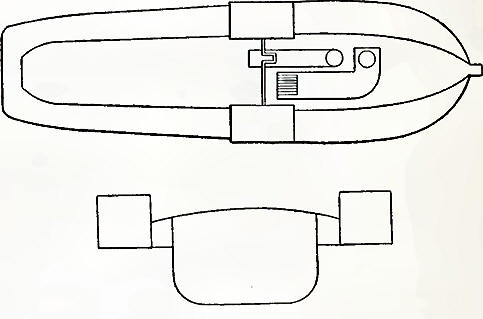
In 1814, six steamers appear to have been built—viz.
the Industry,
Trusty, Princess Charlotte, Prince of Orange, Marjery, and Argyle. The Industry, still
existing, was built, it is said, by Fyfe at Fairlie in 1814, her
builders being afterwards celebrated for their racing yachts; a
reputation which the firm, still flourishing, maintains. Her
dimensions are as follows: Length, 68 ft.; breadth, 17 ft.; depth, 8
ft.; gross tonnage, 69; register, 42; one cylinder, 16 in. in
diameter. She had at first a copper boiler, not an uncommon
arrangement in those early days, of low pressure; but it was
afterwards replaced by an iron one. The original engine was also
replaced about 1826 by the one now on board. One special feature of
interest, which can still be inspected, is the spur-wheel gearing to
connect the engine with the paddle-shaft. From
the grinding sound caused by the spur-wheels she was known at
Greenock as the “ Coffee-mill.” The original engine was by Thomson,
of Tradeston, and the second engine by Caird, of Greenock. The
paddle-wheels are 11 ft. diameter, with floats 2 ft. 9 in. long, ten
on each wheel; stroke of engine, 2 ft.; diameter of shaft, 51 in.;
spur-wheels, 2 ft. and 1-1 ft. in diameter. TheIndustry was
the seventh steamer
on the Clyde, and must now be the oldest steamer in existence. She
plied between Glasgow and Greenock, principally as a luggage boat,
but occasionally ventured down the firth as far as Campbeltown.
Strangely enough, at the present time the Clyde
contains two of the greatest curiosities in marine architecture,
viz. the oldest steamer extant—the Industry—
and the largest vessel in the world—theGreed
Eastern, which
for some time has been lying at the “Tail of the Bank,” oft'
Greenock. The dimensions of the latter, as given in the
advertisement of bill of sale, is: Length, 670'6 ft.; breadth, 82-8
ft.; depth, 60 ft. Tons B.M., 22,927; tons gross, 18,915; tons nett
register, 13,34k Screw engines, 1,600 h.p. nominal;
paddle engines, 1,000 H.P. nominal.
On comparing these dimensions with those of the Industry, we
find that the Great
Eastern is
ten times longer, about five times broader, and seven and a half
times deeper. The tonnage is about three hundred times greater.
It may be interesting to note that the combined
length of these seven precursors of steam traffic on the Clyde was
little over 400 ft., so that, if placed end to end, they could all
have been carried by such a vessel as the Anchor Line steamer Furnessia, now
sailing from the Clyde, which measures 445 ft. long.
The Trusty was
a boat like the Industry, and
is said to have been the first steamer built at Dumbarton; the
builder being Wm. Denny. She was 68 ft. long, with a breadth of 17
ft. 6 in., having a geared side-lever engine of 10 h.p. made
by George Dobbie, Tradeston. Like the Industry, she
got a new engine of greater power at a later date. This boat appears
to have sunk in the river after a collision, but was afterwards
raised and converted into a schooner, and wrecked in 1854 off* Loch
Ryan.
The Princess
Charlotte and Prince
of Orange were
built by Mr. Munn of Greenock, and engined by Boulton & Watt.
The Marjery was
built at Dumbarton by William Denny, and engined by James Cook, with
a single side-lever engine of 10 h.p. Her
dimensions were 63 ft. long by 12 ft. beam. This vessel was sent to
the Thames about 1815. When the Marjery sailed
past the Nore, at which part of the British fleet was lying, she was
closely scrutinized by the old salts on board; one of them, who
belonged to Dumbarton, gave her a cheer, adding, “Well done,
Dumbarton! ”
The Argyle, 78
tons, was built at Port-Glasgow, and engined by James Cook, with a
single side-lever engine of 14 h.p. She
was a similar vessel to the Albion, and
appears to have gone to the Thames in 1815.
In 1815 other six steamers appear to have been added,
viz. the Waterloo,
Argyle No.
2, Greenock,
Caledonia, Dumbarton Castle, and Britannia.
The Waterloo, 90
tons, was built and launched after the celebrated battle was fought,
and was similar to the Argyle. She
plied on the Helensburgh station. The engines were by James Cook,
and were of 20 h.p.
Among the songs which appeared from time to time in
reference to the early boats, one refers to the Waterloo as
follows:
“And now amid the reign of peace
Arts guiding stream we ply,
That makes our wheels, like whirling reels,
O’er yielding water fly.
As our heroes drove their foes that strove
Against the bonnets blue,
On every side the waves divide
Before the Waterloo.”
The Greenock, G2
tons 10 h.p., appears
to have been built by Archibald M'Lauchlan at Dumbarton. The Caledonia, 102
tons, was built by Messrs. Wood, Port-Glasgow. She measured 95 ft. 6
in. long by 15 ft. beam; draft 4h ft.
to 5 ft., and had two engines of 16 h.p. each,
made by the Greenhead Foundry Co. This vessel went in 1816 to the
Thames, and was afterwards placed on the
Rhine. The Dumbarton
Castle, 81
tons 32 h.p. (two
of 16 H.P. each),
built by Archibald M'Laucldan, Dumbarton, and engined by Duncan
MArthur & Co., Camlachie, was the first steamer to make a trip to
Rothesay, and the event was marked by the presentation of a handsome
punchbowl to the captain, James Johnston. This vessel appears to
have been wrecked in the Clyde in 1829. The
Britannia, 109
tons, 32 h.p., with
a draft of 4 ft. G in., measured about 80 ft. long by 16 ft. beam.
Her engines were made by James Cook, and consisted of a pair of
beam-engines and spur-wheels to raise the power to the paddle-shaft,
similar to those of the second Waterloo (see
cut p. 183). The cylinders were 20 in. diameter, with 2 ft. 6 in.
stroke. This vessel plied to Campbeltown and made a trip to
Londonderry, thereby opening up the trade with the latter port. She
appears to have been wrecked off Donaghadee in 1829.
The following is a copy of an advertisement appearing
in the Glasgow
Herald of
June, 1815:—“The proprietors of the Britannia steamboat
beg leave to inform the public that she, according to advertisement,
performed her voyage to Largs, Rothesay, and Campbeltown, and
returned in such a short time, and gave so great satisfaction, that,
owing to an agreement with the public of Campbeltown, they will be
under the necessity of abandoning the voyage to Inveraray, as
advertised for tomorrow, but will upon Monday first, at ten o’clock,
sail for Greenock, Gourock, Rothesay, and Campbeltown, and return on
Wednesday. As the voyage is far, the passengers will be accommodated
with refreshments, suitable and agreeable for them.”
The Britannia appears
to have had a beam-engine. The Industry engine
is of the side-lever type; very much like a beam-engine inverted.
Beam-engines are still used in America to a large extent; one of the
largest examples of these being the engine of the Pilgrim, built
in 1882, and now plying on the Fall River route by Long Island
Sound, between New York and Boston. These engines have not found
favour on the Clyde, but occasionally boats fitted with them for the
China river service may be seen at the works of Messrs. A. & J.
Inglis. About the last large mail paddle-steamer to be fitted with
the side-lever engine was the Persia, of
the Cunard Co., engined by Messrs. R. Napier, Glasgow. Another
existing example of the side lever can still be seen at Dumbarton,
and from its position can be readily inspected. There, the engine of
the Leven, the
first marine engine made by Robert Napier in 1824, has been erected
on a pedestal at the foot of the great rock which has for so long
silently looked down on the productions of the toiling hands and
inventive brains of the workers of the Clyde.
In 1816 we have further additions, viz. the Neptune,
Albion, Rothesay Castle, Lord Nelson, Lady of the Lake, and Duke
of Wellington. This
latter vessel appears to have been built by William Denny in 1817,
but was a few years afterwards lengthened and named the Highland
Chieftain, running
to the Highlands till about 1838. Of these the Albion, 92
tons, was built by J. Wood, and measured about 70 ft. by 13 ft.
beam, with draft of 4 ft. The engine (side-lever) of 20 h.p. was
by James Cook, the cylinder being 22 in. diameter, with a 2-ft.
stroke. She plied to Largs. The cost of this vessel is stated as—

The Lady
of the Lake, engined
by James Cook with a single side-lever engine, appears to have been
transferred to the Firth of Forth, and after plying there was sent
to the Elbe, but was afterwards brought back. In 1817 only two boats
appear to have been added, viz. the Marion and
the Defiance. Of
these the Marion appears
to have been the first steamer on Loch Lomond, where she plied in
1820 in connection with the Post
Boy steamer
from Glasgow. The year 1818 brought several additions, viz. the Rob
Roy, Marquis of Bute, Woodford, Active, and Despatch. The Rob
Roy is
the most interesting, as she was the first steamer to ply to
Belfast. She was 90 tons and of 30 h.p., with
a draft of 7 ft., and was built by William Denny, at Dumbarton,
engined with a single side-lever engine by David Napier, and was
latterly transferred to the Dover and Calais service. Previous to
starting this steamer it is said that Mr. Napier crossed to Belfast
during a storm in a sailing vessel, and watching the effect of the
waves was convinced steam could be utilized to overcome them. He
then by means of experiments on model boats determined to give his
proposed steamer a sharper entrance at the bow than was at that time
common for the river steamers.
In 1819 the second Waterloo was
built by Scott of Greenock, and was the longest steamer afloat at
that time, measuring about 120 feet long by 22 feet beam. She had
two beam-engines with 30-inch cylinders and 3 feet stroke,with
spur-wheels to connect with the paddle-shaft. See annexed cut.
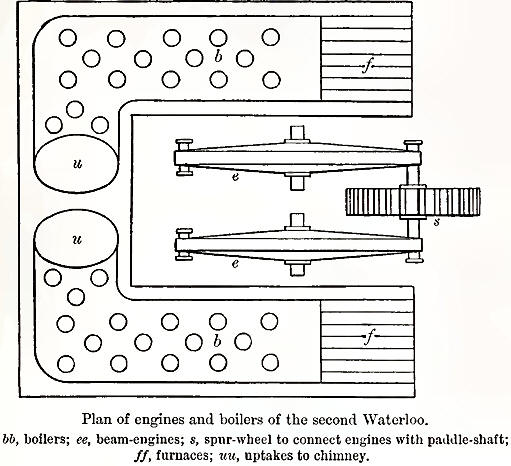
In 1819 Mr. David Napier had the Talbot built
for him by Messrs. Wood. She was 150 tons, and had two of Mr.
Napier’s engines of 30 h.p. each.
The Talbot plied
between Holyhead and Dublin, and appears to have been a very
complete and efficient vessel. Another vessel, the Ivanhoe, was
added to this route. She was 170 tons burthen, built by Scott of
Greenock, and engined by Mr. D. Napier with engines of 60 h.p. In
the same year
Mr. D. Napier established the first line of steamers
between Glasgow and Liverpool, the Robert
Bruce of
150 tons and 60 h.p. being
the first to start. She was built by Messrs. Wood and engined by Mr.
D. Napier.
Two others were added, viz. the Superb, in
1820, of 240 tons and 70 h.p., and
the Eclipse, in
1821, of 240 tons and 60 h.p. The
former was built by Scott, and the latter by Steele of Greenock, the
engines in both cases being by Mr. D. Napier.
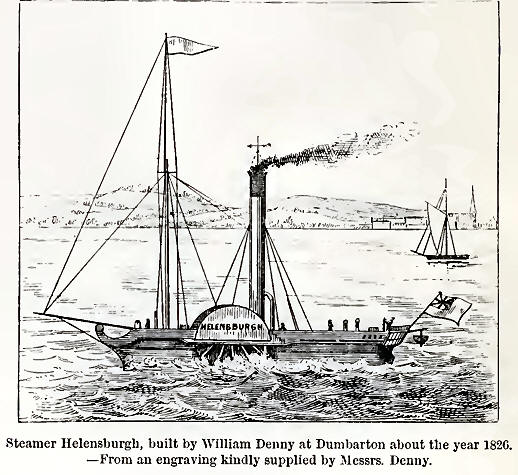
We may now look at one or two pictures of the early
boats, and their successors of the present day. Compare the Superb of
1820, and the Etruria, one
of the largest and most powerful vessels now 011 the
Atlantic service. The Steamboat Companion for 1820 tells us that
“The Superb, is
at this moment the finest, largest, and most powerful steam vessel
in Britain. She registers 241 tons, and is impelled l>y two very
fine engines of 36 H.
P. each,
to which copper boilers are attached. The average duration of the
passage from the Clyde to Liverpool does not exceed thirty hours;
fare, £2, 15s.” Contrast this with what the Times for
1885 says:
“The Etruria is
a sister ship to the Umbria, both
built by John Elder & Co., of Fairfield, Govan, the largest, most
finished, and fastest vessels in the Atlantic service. She is built
entirely of steel, and is divided into ten water-tight compartments.
She is 520 ft. long by 57 ft. 3 in. broad, and 41 ft. deep. The
coming season will be an interesting one to the Atlantic traveller
and to those who watch the performance of the vessels. The list is
filled up for the present. There is nothing on the stocks and
nothing projected to compete with what is on the water, and the
public interest will centre in nine vessels, constructed within the
last eight years, as follows:—
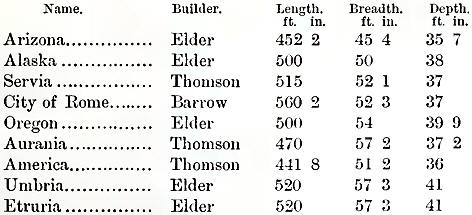
“The Etruria is
fitted to accommodate 720 first-class passengers. Several of the
state-rooms are fitted en
suite for
family use, and every advantage has been taken of the breadth of the
vessel to afford variety and greater space in the accommodation. The
saloon will seat 280 people at dinner, and as the electric lamps are
fixed high up near the ceiling by slender pendants the view is
unobstructed throughout the chamber. The panelling of the saloon is
all in light wainscot oak, with a dark walnut sideboard at the
service end and a bookcase at the other. Above, in the form of a
sort of gallery, is a music-room; and on the same upper deck are a
number of superior state-rooms in the middle of the ship. Above
these, and running for 300 feet in length throughout the entire
breadth of the ship, is a promenade deck. Here is the captain’s room
and a large saloon, exclusively set apart for ladies, sumptuously
upholstered in green velvet and panelled in maple. Below, on the
main deck, on a level with the saloon, is a boudoir, which forms a
vestibule to the baths and lavatories set apart exclusively for
ladies. Altogether there are 13 marble baths, fitted with steam and
shower apparatus; and lavatory accommodation is dispersed throughout
the ship. On the main lower decks are placed the major portion of
the state-rooms. Each of them is provided with a hot-water heating
apparatus, an electric light, and a life-saving cork jacket for each
berth. The smoking-room, which is unusually large, is fitted with
red leather benches/and is panelled in maple and oak. It is placed
on the upper deck. The electric light is produced by four of
Siemens’s machines, each with its own three-cylinder engine. Three
of them are sufB-cient to maintain the whole 850 lamps of the ship,
so that one is always in reserve, and oil lamps are entirely
dispensed with. The passages, the engine-room, and boiler-house are
lighted day and night, and some of the lights of the saloon are also
maintained during the night. The engines are marvels of
construction, and are unequalled, except by those of the Umbria, for
strength, power, and simplicity. With good coals they are capable of
indicating upwards of 14,000 horse-power, with nine boilers, but the
speed attained by the Etruria has
been secured by some thousand horse-power less than the maximum. The
boilers are fired by 72 of Fox’s corrugated furnaces. They work at a
pressure of 100 lbs., which was maintained during the cruise with a
total absence of smoke, even with inferior coals.”
In speaking of the progress of steam navigation, Dr.
Cleland says, “ The success of steamboats on the Clyde induced some
gentlemen in Dublin, to order two vessels to be made to ply as
packets in the channel between Dublin and Holyhead, with a view of
ultimately carrying the mails. They were built by Mr. James Munn,
Greenock, have engines of twenty horse-power, made by Mr. James
Cook, Tradestown, Glasgow, and are named Britannia and Hibernia. Mr
Cook, whose eminent abilities as an engineer, have enabled him to
make numerous improvements on machinery, has been very successful in
constructing the paddles of these packets, so that one man can
easily raise them from five to six feet out of the water, while the
engine is at work, in the event of a heavy gale making that measure
necessary.” The author is indebted to Mr. Robert Cook, a nephew of
the Mr. Cook referred to, for much personal information of the
sizes, powers, and general appearance of these early steamers.
We have clearly in the Superb reached
a point, eight years later only than the launching of the Comet, when
steam navigation on our coast may be considered completely and
efficiently established. Certainly the time stated as taken on the
voyage to Liverpool is long, but it took some years and many
improvements in both vessels and machinery to reduce it to 18 hours
from Greenock by the
Unicorn in
1837, and in 1841 to 16½ hours by the Princess
Royal. The
Liverpool steamers about 1837, the Unicorn and Actceon, appear
to have been very handsomely furnished, and even carried a chaplain
with them who conducted divine service on Sunday. The chaplain had a
special room to himself with a brass plate marked “Chaplain’s Room.”
Notwithstanding all these advantages it was still considered a
serious event to make the Liverpool journey, some travellers making
their “will” and taking a special farewell of their friends ere they
started. |

